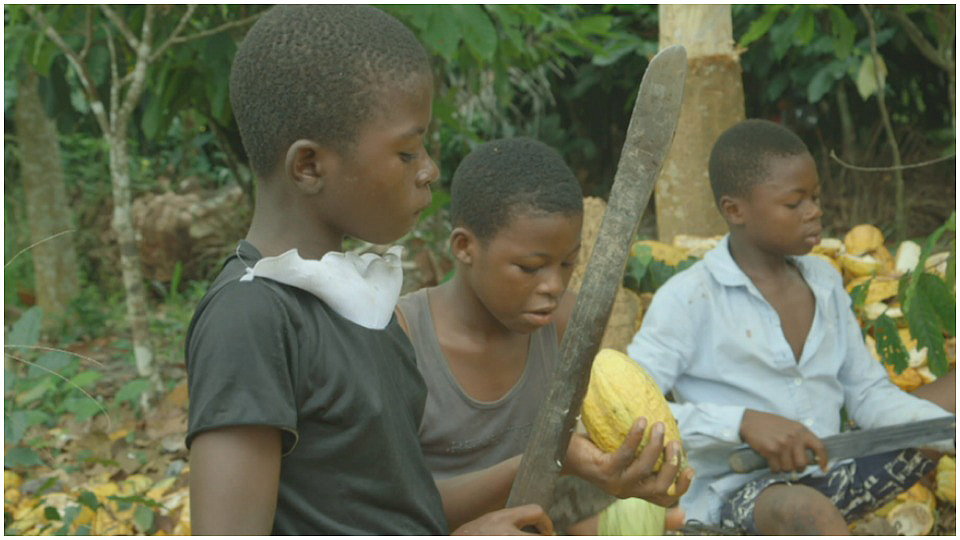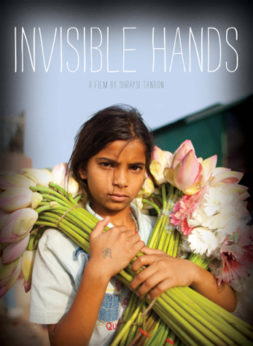
The new documentary Invisible Hands brings to the big screen the subject of child labor and trafficking within the supply chains of the world’s biggest corporations, which produce the lion’s share of our most sought-after products. The film offers a harrowing account of children as young as five years old making items we buy and consume every day. Chilling undercover footage shows children being sold like animals to the highest bidder and others being abused by this pervasive slave labor. It digs deep into a modern-day system of involuntary servitude quietly supported by some of the world’s largest companies. It demands to know why top stakeholders continue to engage in this unlawful and immoral practice.
Supporters of the documentary include UNICEF, the International Labour Organization, Human Rights Watch and Humanity United.
“Today there are roughly 200 million children working as child laborers around the world,” says director and producer Shraysi Tandon. “Many of these children are forced, trafficked, and held in factories, sweatshops and farms against their will. This isn’t just taking place in a poor, remote village in Africa or Southeast Asia, as is often thought because of extensive media coverage; it is happening right here in the United States too.
“Over the course of two years, I had the privilege of working with some of the most renowned activists, investigative journalists, academics and nonprofit leaders who guided my team…into the dark underbelly of the global labor market and showed us the people who were really making our products. The great Elie Wiesel once said, ‘There may be times when we are powerless to prevent injustices, but there must never be a time when we fail to protest.’ This film is my protest against the perpetrators who exploit the most innocent, vulnerable and voiceless members of society—our children.
Tandon has found “invisible children” on several continents and focuses on a few industries in India, Indonesia, Ghana, China and the United States. The maps she includes show that only a small handful of countries in the world are completely free of child or slave labor.
Capitalism is the driving force

The driving force everywhere is global capitalism, which pays such low wages to workers that families are required to send their children to work if they are to survive. At the same time, the jobs these kids work leave them exposed to noxious chemicals, pesticides and pollutants, especially dangerous in bodies that are still forming and growing.
One of the most remarkable aspects to this documentary is the camera access the filmmakers achieved in places where employers surely would not have wanted film coverage. In small workshops in India we see children employed in metal work, particularly jewelry making, sewing and embroidery. There, as elsewhere in the world, children in virtual slavery are deprived of an education, opportunities for achievement, and their physical wellbeing.
It is estimated that some 30 million children under the age of 14 are working in India. Many are recruited at the age of 7 or 8 from poor families, and they are worked for 16 to 18 hours a day. Carpets and rugs are a major industry in which children work. Children who spend their young working lives cross-legged in front of a loom will grow up with deformed legs and weakened eyesight. As one traumatized boy says, who fortunately was rescued from his fate and placed in a rehabilitation center, “When I was working, I never understood what was right and what was wrong.”
Another industry employing children is the mining of mica, used in car paint (my 2008 Prius is “silver pine mica” in color) and in cosmetics for that alluring, glittery look. Most mica in the world comes from India.
The cameras turn to Indonesia, greatest producer of palm oil, a product used for extending the shelf life of many commercial products such as processed food and cosmetics. Environmentalists have decried the palm oil plantations which have metastasized across the tropical world, eating up farms, forests and grazing land. Here the focus is on child labor. Plantation owners set impossibly high daily production goals for rural workers which can only be met by forcing the children to help out. There’s no legal recourse, and there’s no protection—gloves, masks, clothing, boots—supplied to ward off dangerous toxic chemicals such as paraquat. Government labor inspectors are unknown: There may be some on the payroll, but far too few, and rarely seen.
For those of us who have never quite understood the importance of palm oil, the film provides a quick visual survey of the myriad of name-brand products we consume every single day without exception, that contain this ingredient. Of course the major producers disclaim any responsibility for child labor and try to pass off the issue as the untraceable work standards of their many contractors and subcontractors in far-off, unreachable provinces. The complicit, willful ignorance is stunning.
The filmmakers take us on a brief excursion to the Democratic Republic of Congo to visit the cobalt mines where children are slaving away. Again, the multi-layered chain of hiring conceals responsibility under so many levels of obfuscation that manufacturers are able to convince themselves and their customers that all is well on the labor front. To appease their investors and the general public, most international companies today even carry fair labor standard policies in their official statements, but few people take the trouble to verify how much they are actually in compliance.
Our child labor travelogue takes us back to Indonesia’s tobacco farms. It is well known that exposure to nicotine comes not only from inhaling tobacco smoke but from handling the leaves themselves. Nicotine poisoning can be bad enough on it own, with its proven neurological harm especially for bodies still maturing. Add to that the effects of pesticides and we have the recipe for a population of sickly young people who will sooner or later become a burden on society. The filmmakers remind us that we are not talking about local tobacco brands that we can expect to be of low quality, but the biggest names in the tobacco industry: Philip Morris, for one, declined to be interviewed for this documentary.
For American filmgoers perhaps the saddest portion of the documentary is the segment on young tobacco workers in our own country. Legally a child as young as 12 can be employed in agricultural labor, although even that age goes unobserved in many places. For small family farms there is no age limit at all. These kids, American citizens, who are put to work in tobacco fields habitually don’t attend school and will be trapped in a cycle of poverty all their lives. The agricultural exception to national labor laws was part of the Southern Democrats’ deal with FDR’s New Deal; it also meant to exclude African-American workers who were largely employed in field work.
Owing to politics, tobacco farms in the U.S. use pesticides, herbicides and chemicals that have been banned in other countries. The Obama administration tried to ban chlorpyrifos, one of the worst of these chemicals, manufactured by Dow—the infamous producer of napalm. Dow contributed at least $1 million to Donald Trump’s campaign, and as soon as the man who came in second in the popular vote came into office, he immediately set about deregulating the restrictions—in order to make American industry great again, naturally. Dow’s CEO personally attended Trump’s signing ceremony where he removed the ban on chlorpyrifos.
Let’s talk about chocolate
Ghana and Côte d’Ivoire (Ivory Coast) are the two major producers of cacao, together producing 60 percent of the world’s supply. Cacao beans are the raw material from which chocolate is created. Four million people in those countries depend on cacao for their livelihood. Of those, 2 million are child workers. A couple of decades ago, 20 percent of the market price of chocolate went to the farmers. It is now only 6 percent. Such is the degree of concentration of wealth in fewer and fewer hands.
Many of the child workers are little more than slaves. They are trafficked into Ghana, the country the film concentrates on most, from Burkina Faso and Nigeria, and many never go back home. They are contracted for a ten-year term, during which time they are not paid at all and cannot leave. In theory, they receive their pay at the end of ten years. Farmers simply order kids from other countries. Labor brokers show up in poverty-stricken villages and for all practical purposes steal children with false promises for labor in the cacao industry. The film also shows scenes of outright purchasing of children as cacao workers.
Sen. Tom Harkin and Rep. Eliot Engel some years back tried to pass a protocol on child labor with enforcement of labor standards in the cacao industry, but deadlines kept getting missed. Now it’s virtually a dead issue. Local enforcement of labor conditions is nonexistent.
In the film the cinematographers captured an entire transaction of buying children. Money changed hands. The film was shown to officials in the Ghanaian government, and when the kids were delivered to the farm, police moved in and arrested the traffickers. Clearly this was an isolated incident born of shaming the authorities.
To me, the single most poignant moment in this chapter came when an interviewer asked one of the children if he knew what “chocolate” was. The boy had never heard the term.
Every major name producer of chocolate gets its cacao from these countries, but true to form, they are blind to the abuses at the source.
China is a special case, one that exemplifies both the positive and the awful in globalization. China has become the largest manufacturing country in the world in a few short years, and extreme poverty has been lowered significantly. Child labor, especially in the countryside, used to be commonplace, but then mandatory schooling came in. Ingeniously, China came up with a novel approach. Children of an average age of 16, but some as young as 14 or 15, are recruited during their summer breaks into “internship” programs in manufacturing for the global market. These students provide cheap labor at short notice, the Chinese version of “right sizing” and “right timing” in the labor market. The labor they perform is unrelated to their field of study, but they are in a dicey position to protest, for if they do not complete their “internship,” they cannot graduate. They too represent a form of captive labor.
The filmmakers have a fairly dim view of global corporate greed, but they do give Apple some credit for aggressive investigation into the labor conditions in its factories, citing it as a good model.
The experts speak
Aside from the truly eye-opening footage in factory and field, a viewer will see in Invisible Hands several experts and witnesses with vital roles to play. One is Kailash Satyarthi, an Indian children’s rights activist and the 2014 Nobel Peace Prize recipient, which he shared together with the young Afghan Malala Yousafzai. Satyarthi is the founder of Bachpan Bachao Andolan (Save Childhood Movement), the Kailash Satyarthi Children’s Foundation, Global March Against Child Labor and GoodWeave International. To date, Satyarthi and his team have saved over 87,000 children from child slavery and trafficking.
Another intriguing informant is Anas Aremeyaw Anas, a Ghanaian investigative journalist who uses his anonymity (he appears in disguise) to expose human rights abuses and anti-corruption across Ghana and sub-Saharan Africa. Foreign Policy magazine named him as one of 2015’s leading global thinkers. He was also given the Heroes Acting to End Modern-Day Slavery award by the U.S. Department of State for his contribution to end human trafficking.
Ben Skinner also makes several comments in the film. He is the founder of Transparentem, a nonprofit organization that focuses on eliminating human rights and environmental abuses from global supply chains. Another commentator is author Nicholas Kristof, a columnist for the New York Times covering human rights and global affairs, who has won Pulitzer Prizes along with several other humanitarian awards.
We also hear from Siddharth Kara, director of the Program on Human Trafficking and Modern Slavery at Harvard’s Kennedy School of Government, and author of the award-winning book trilogy on modern slavery, Sex Trafficking: Inside the Business of Modern Slavery, Bonded Labor: Tackling the System of Slavery in South Asia, and Modern Slavery: A Modern Perspective. Mark Barenberg, professor of law and director of the Program on Labor Law and Political Economy at Columbia Law School, has drafted many federal and state laws regulating labor conditions in companies supplying U.S. manufacturers and governments.
Margaret Wurth is a senior researcher with the Children’s Rights Division of Human Rights Watch, where she focuses on child labor and health. Wurth has undertaken research on hazardous child labor in gold mining in the Philippines and in tobacco farming in the United States, Brazil, and Indonesia. Finally we also get to meet Andreas Harsono, an Indonesian human rights advocate who has been the Indonesia researcher for Human Rights Watch since 2008.
Vote with your wallet?
The GoodWeave label on woven items signifies that the product is free of child labor. Child Labor Free and Fair Trade labels are also helpful guides. The film suggests that corporations are far more important determiners of policy than governments, and also more vulnerable to consumer action. Consumers are asked to vote with their wallets by constantly inquiring at retail stores, “How can you guarantee that this product was not made by child or slave labor?” When corporations hear it enough, they will presumably start responding to consumer demand.
In addition, there are rescue operations in some of these countries which flout the law and, whether “legally” or not, remove the children from their oppression, returning them to their families or enrolling them in schools. The film ends with some happy, smiling children finally understanding that the future is now theirs to create for themselves.
After all we have seen, compressed into a taut 74 minutes, it would appear that consumer activism and vigilante rescue operations are ultimately inadequate resolutions to a global problem of these dimensions. But neither can they be dismissed: The student movement to ban sweatshop-manufactured school clothing has chalked up some major wins. In the end, however, the solution must be political: The whole society at large must be organized in such a way so as to make impossible the conditions documented here and guarantee a healthy childhood for every kid. But I know: Easier said than done. It will take a mass worldwide movement of revolutionary proportions to address and end the scourge of child labor and slavery.
Invisible Hands opens in New York on Nov. 23, and in Los Angeles on Nov. 30. See it and you will never again enter a supermarket with the same eyes—and definitely not with the same heart. Hopefully you won’t leave with the same products. Might be time to start patronizing your local farmer’s market.










